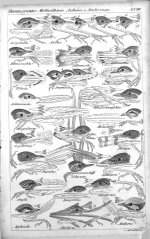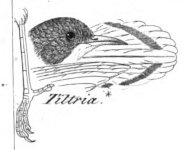Interim report!
So far so good … this far we´ve been able to solve quite a few (or at least add some information on most) of those earlier "unseen" ones. Not bad!
This only leave us with the following:
gerhardi:
● in the subspecies
Zosterops senegalensis gerhardi VAN DEN ELZEN & KÖNIG 1983 (OD,
here).
= the German ornithologist
Gerhard Nikolaus (fl. 2010), writer of
Distribution Atlas of Sudan's Birds with Notes on Habitat and Status 1987 and
Birds of South Sudan 1989 ... etc. etc.
Also see
this link, and the earlier Bird Forum thread
here.
passmori
● … in the invalid "
Cygnus Passmori" HINCKS 1865 (OD,
here) [Syn.
Cygnus buccinator RICHARDSON 1832]
=
most likely the British (later Canadian)
Samuel Wilkins Passmore (b. ca. 1805), of Toronto, taxidermist to the
Montreal Natural History Society …
mariae
● … in "
T. [
Trochilus]
Mariæ" (OD,
here).
=
most likely (I agree), thanks to the clever "guess" by Martin and the links in his Post No. #18: the French
Marie Wachanru (
1821–1853), whose full (maiden) name was
Marie-Rose Gaudemard. Wife of the French naturalist, entomologist Alexandre Wachanru ... etc. etc. much more on her (if you know French) in that Obituary.
and then it´s the tricky, still unidentified:
●
Tiltria
Perhaps we should put this in the Identification Forum!!!
Yes, James, why not? Do that. Maybe the Identification guys would be able to tell us what it could be!?
And, by the way; while on the subject of identification!
nigellii
● in the "Nigells Pheasant-Grouse.
Tetraogallus Nigellii" GRAY … couldn´t the
nigellii and
nigelli commemorate the same man (i.e. Dr Macneill)
!? And be synonymous of (or at least intended at) the same (of today's valid) species? I think that was the original intention …
See link
here, and Wiki's Taxonomy and systematics chapter (
here) for Himalayan snowcock (
Tetraogallus himalayensis).
---
However, the following are, this far, still totally unexplained:
●
libussa (OD,
here)
●
Merva … (OD,
here)
●
lucieni (OD,
here)
"… proposons de lui donner le nom d’un jeune Français, collaborateur de MM. le Dr Lucan et Petit à qui nous devons tant de fait nouveaux intéressant lʼornithologi de la région du Congo."
The answer to who this "
Lucien" was is probably hidden in Louis Petit's book
Dix années de chasses d'un jeune naturaliste au Congo 1926 (apparently nowhere to be found on-line).
●
sabinae a k a "
Le C.[
Colibri]
de Sabine" (OD,
here)
●
tounelieri
… in the subspecies
Hypotaenidia philippensis tounelieri SCHODDE & NAUROIS 1982 as "
Gallirallus philippensis tounelieri" (OD,
here, p.131+):
"Accordingly, we treat our series from the Coral Sea as a new subspecies, naming it after a colleague of de Naurois,
Gallirallus philippensis tounelieri, n. subsp."
Who this colleague was, or is (presumably a Mr.
Tounelier) we still do not know.
Anyone know anything on any of these names?
PS. "
Himelia", in No.33 ... sorry for the earlier (erroneous) link. Wrong year, wrong journal! :h?:
It´s this one (
here)
!!!
Not to be confused with
Himalia (on p.224, same volume).
PPS. And the
Leocadiae (
vs Aline) still remain a mystery?
x







